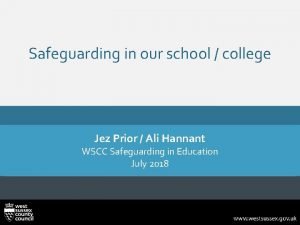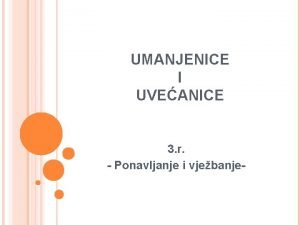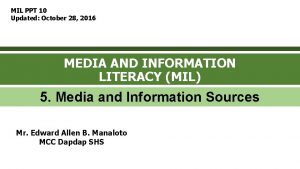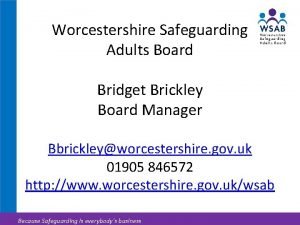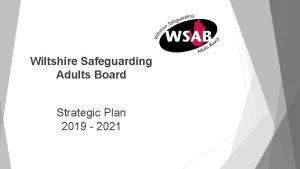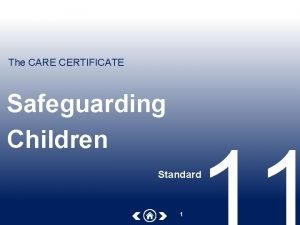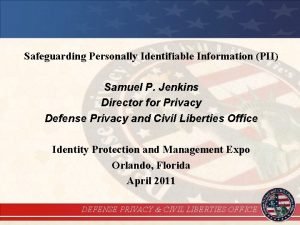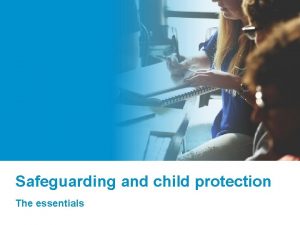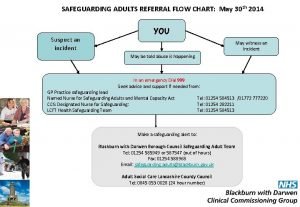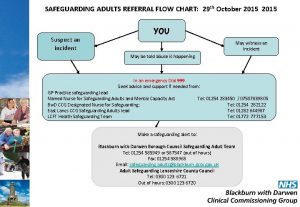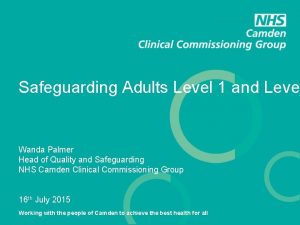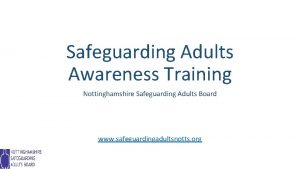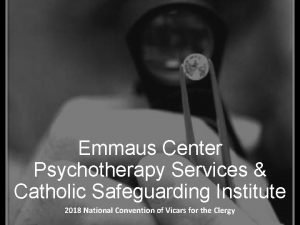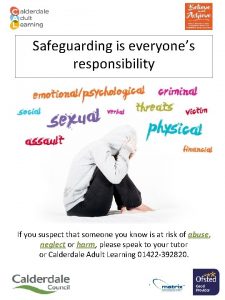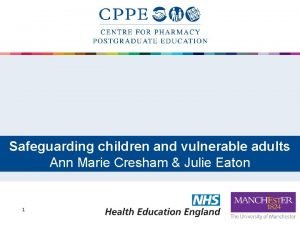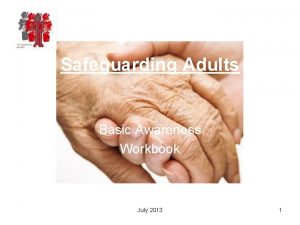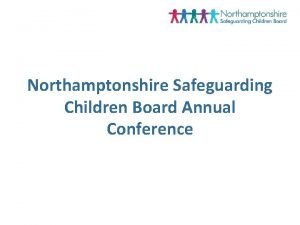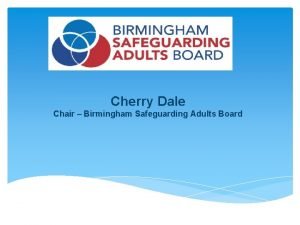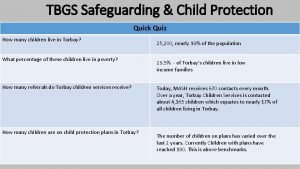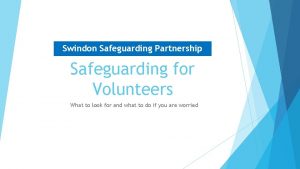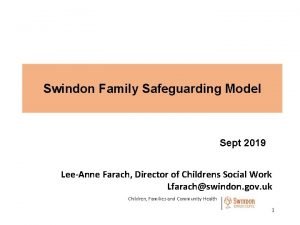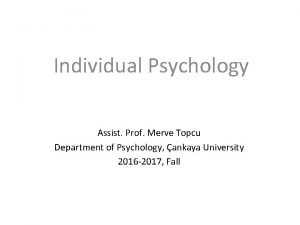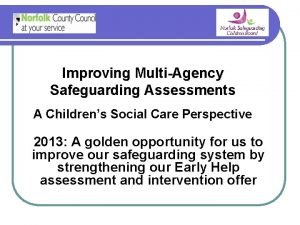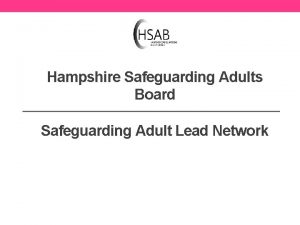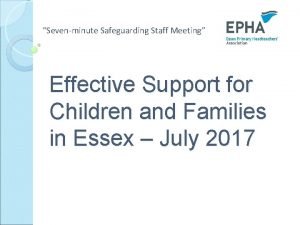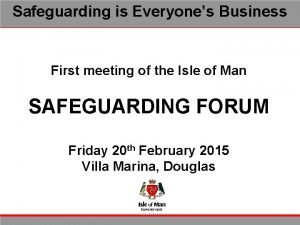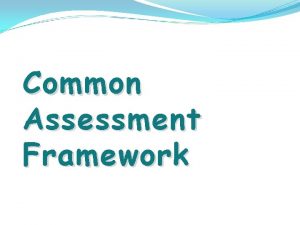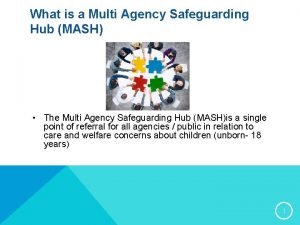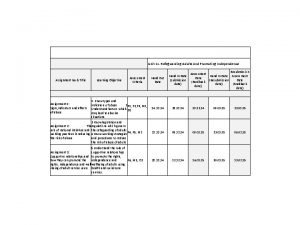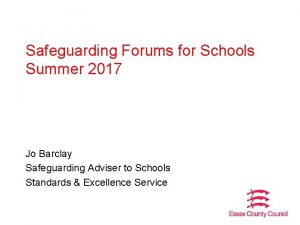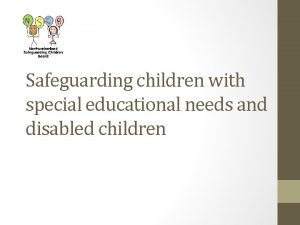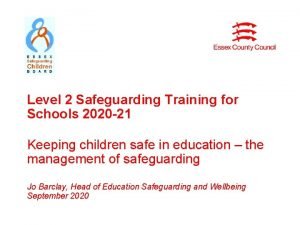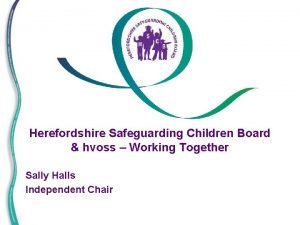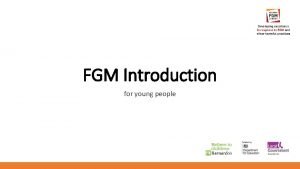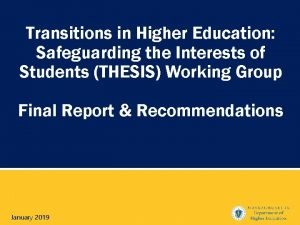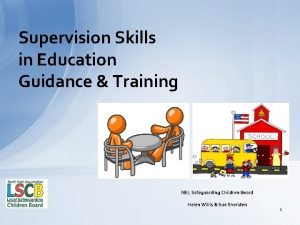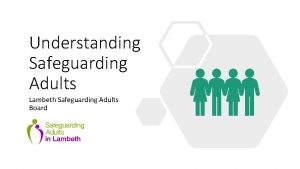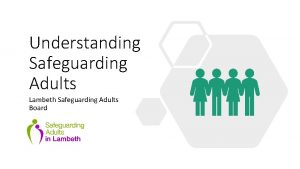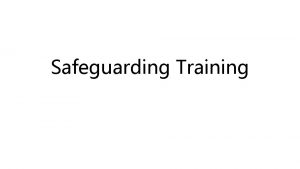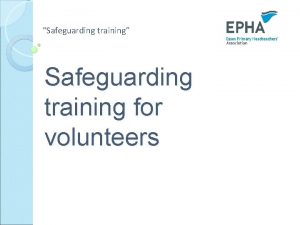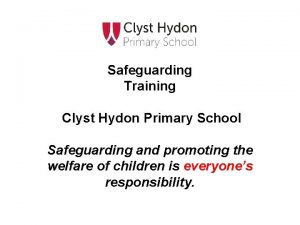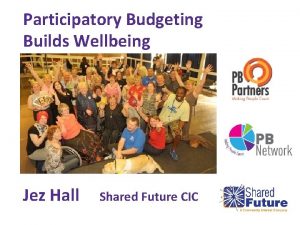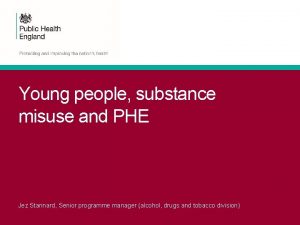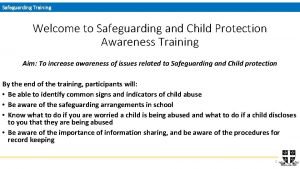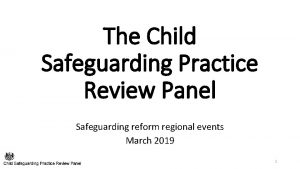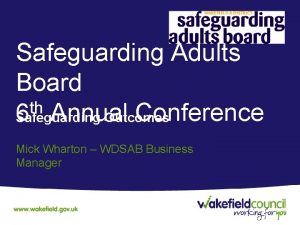Safeguarding in our school college Jez Prior Ali


































































- Slides: 66

Safeguarding in our school / college Jez Prior / Ali Hannant WSCC Safeguarding in Education July 2018

Learning Objectives • Awareness of responsibilities to safeguard children and how they relate to your job • Safeguarding Culture in our school / college • Maximising the opportunities to teach safeguarding to our pupils • How to recognise indicators of abuse • What to do if you have concerns • How to contact MASH / How to contact LADO • Safe working practice by adults in our school / college and how to raise concerns

Sensitivity Child Protection is a highly emotive and emotional subject. We each carry with us our own experience of being a child and some of us will also be parents, grandparents, voluntary workers etc. . with children. Please: § Respect each other and each other’s experiences § Keep any personal material shared today private, unless detrimental to the welfare of a child § Be sensitive, as talking about child abuse may raise personal as well as professional issues for ourselves and each other

Safeguarding Leads in Our School • XXXXXX is the designated safeguarding lead • XXXXXX is / are the deputy safeguarding leads • XXXXXX is the safeguarding governor

Safeguarding Culture • KCSi. E 2018 page 21 para 78…. • Governing bodies and proprietors should recognise the expertise staff built by undertaking safeguarding training and managing safeguarding concerns on a daily basis. Opportunity should therefore be provided for staff to contribute to and shape safeguarding arrangements and child protection policy • It is ALL OUR RESPONSIBILITY • Challenge / support / question – could it be done better…

Safeguarding Culture in our School • It is ALL of OUR RESPONSIBILITY • A CHILD CENTRED and COORDINATED approach to SAFEGUARDING (KCSi. E 18 – page 3) • It could happen to any of our children • It could happen here • How will I do all I can to contribute to an effective safeguarding system in our school • Am I prepared to challenge if I don’t think enough is being done to safeguard a child • Do I think safeguarding all the time – challenging that stranger in school / checking hazardous substances are locked away / doors are secure / trip hazards are identified…. .

To help you… Placed around the school at various locations are; § Copies of School Child Protection Policy § Copies of Part 1 KCSi. E § Copies of the Confidential Reporting Policy § Reporting forms and body / skin maps

Safeguarding Framework National legislation & statutory guidance BOTH HAVE BEEN UPDATED FOR 2018 T AR 1 P All staff should read and UNDERSTAND PART 1

Safeguarding is EVERYONE’s responsibility • Safeguarding and promoting the welfare of children is everyone’s responsibility. Everyone who comes into contact with children and their families has a role to play. • In order to fulfil this responsibility effectively, all professionals should make sure their approach is childcentred. This means that they should consider, at all times, what is in the best interests of the child. • This means inside and outside of school

The role of school and college staff School and college staff are particularly important as they are in a position to identify concerns early, provide help for children, and prevent concerns from escalating. • All staff have a responsibility to provide a safe environment in which children can learn. • All staff should be prepared to identify children who may benefit from early help • Any staff member who has a concern about a child’s welfare should be able to follow the referral processes

Keeping Children Safe in Education states… All staff should be aware of systems within their school or college which support safeguarding and these should be explained to them as part of staff induction. This should include: • the child protection policy; • the behaviour policy • the staff behaviour policy (sometimes called a code of conduct); • the safeguarding response to children who go missing from education; and • the role of the designated safeguarding lead (including the identity of the designated safeguarding lead any deputies).

Training All staff, including volunteers should; • be trained at least annually • receive updates regularly, for example via emails, staff meetings, bulletins etc. . • be aware of the Early Help Process • know how to make a referral to MASH • know how to make a referral to the LADO

Working Together 2018 Children were asked what they wanted from an effective safeguarding system. They said… • vigilance: to have adults notice when things are troubling them • understanding and action: to understand what is happening; to be heard and understood; and to have that understanding acted upon • stability: to be able to develop an ongoing stable relationship of trust with those helping them • respect: to be treated with the expectation that they are competent rather than not

Continued… • information and engagement: to be informed about and involved in procedures, decisions, concerns and plans • explanation: to be informed of the outcome of assessments and decisions and reasons when their views have not met with a positive response • support: to be provided with support in their own right as well as a member of their family • advocacy: to be provided with advocacy to assist them in putting forward their views • protection: to be protected against all forms of abuse and discrimination and the right to special protection and help if a refugee

Safeguarding is defined as…. • protecting children from maltreatment • preventing impairment of children's health or development • ensuring that children grow up in circumstances consistent with the provision of safe and effective care • taking action to enable all children to have the best outcomes • Page 6 Working Together 2018

Child Protection is… Protecting a child who has or is likely to be subjected to…. • Significant Harm • There are no absolute criteria on which to rely to determine what constitutes Significant Harm. It is often a compilation of significant events, both acute and / or longstanding, which impact on the child's physical and psychological development……. • Pan Sussex Child Protection & Safeguarding Procedures

Four Categories of Abuse § § Neglect Physical Sexual Emotional

• Divide into groups and consider the four areas of abuse • give a definition and some examples of each category • • Neglect Physical Sexual Emotional

Neglect Persistent failure to meet a child’s basic physical and/or psychological needs likely to result in the serious impairment of the child’s health or development, such as: – Substance misuse in pregnancy – Failing to provide adequate food/shelter/clothing/ protection from danger and abandonment – Failing to ensure adequate supervision – Failing to provide appropriate medical care – Failing to respond to child’s basic emotional needs

Possible Indicators of Neglect

Neglect Identification & Management Tool (NIMT) • Introduced by West Sussex Safeguarding Children Board • A tool to galvanise thoughts and practice around responding to neglect • Schools engage in using this tool • NIMT

Physical Abuse • • Shaking Throwing Poisoning Burning / scalding Drowning Hitting Suffocating Perplexing Cases

Some possible indicators of Physical Abuse

Sexual Abuse Forcing or enticing a child to take part in: – Sexual activities, including exploitation (money / drugs / alcohol), whether the child is aware of what is happening or not – Physical contact including penetrative and nonpenetrative acts – Non-contact activities including children looking at or being involved in the production of pornographic material, watching sexual activities, encouraged to behave in sexually inappropriate ways, and verbal sexual abuse

Possible indicators of Sexual Abuse

Emotional Abuse Persistent emotional ill-treatment of a child causing severe and persistent adverse effects on child’s emotional development: • Conveying that children are worthless/unloved • Imposing age-inappropriate expectations on children e. g. caring for an alcohol-addicted parent • Seeing/hearing the ill-treatment of another (Domestic Violence) • Serious / persistent bullying

Possible Indicators

Child’s Voice Does EVERY child in your school know someone to talk to if they are worried about something? • Do they – really? How do you know? • Do you understand what is going on for the child? • Some children are on the radar almost constantly - what about the child that seems happy, attends and behaves well – is school their safe place? Remember what children said they wanted from an effective safeguarding system…. Two of what they said; • • • vigilance: to have adults notice when things are troubling them understanding and action: to understand what is happening; to be heard and understood; and to have that understanding acted upon

Child’s Voice • • • A child may only disclose once Be prepared Know what to do YOU could be the DIFFERENCE If you are concerned YOU MUST SPEAK to your DSL

Children with Special Educational Needs & Disabilities Children with SEN & D can face additional safeguarding challenges • Assumptions that indicators of possible abuse such as behaviour, mood and injury relate to the child’s disability without further exploration; • Children with SEN and disabilities can be disproportionally impacted by things like bullying- without outwardly showing any signs; • Communication barriers and difficulties in overcoming these barriers. 30 How do we make sure we hear these children too?

Safeguarding in our Curriculum • KCSi. E 2018 • Governing bodies and proprietors should ensure that children are taught about safeguarding, including online safety. Schools should consider this as part of providing a broad and balanced curriculum. • What does an education for safeguarding curriculum contain? • How will we do that here? • How can we maximise the opportunities ? • How can we make it a consistent theme across the year and in all year groups? • How do we make appropriate and accessible for ALL of our students?

SPECIFIC SAFEGUARDING SITUATIONS Sexual Violence trafficking female genital mutilation (FGM) Sexual Harassment child sexual bullying including exploitation (CSE) cyberbullying Children Missing Education mental health More info on all of these areas can be found in vate fostering Homelessness gangs and youth violence radicalisation domestic violence School Model Child Protection Policy sexting forced marriage gender-based violence/violence against women and girls (VAWG) Children in Court cases

CHILD SEXUAL EXPLOITATION – potential signs • • • Going missing for periods of time or regularly coming home late; Regularly missing school or education or not taking part in education; Appearing with unexplained gifts or new possessions; Associating with other young people involved in exploitation; Having older boyfriends or girlfriends; Suffering from sexually transmitted infections; Mood swings or changes in emotional wellbeing; Drug and alcohol misuse; and Displaying inappropriate sexualised behaviour. Can be on-line as well as contact abuse A practitioners guide. https: //www. gov. uk/government/uploads/system/uploads/attachment _data/file/279511/step_by_step_guide. pdf 33

CSE in West Sussex – Learning from Serious Case Review ‘Key’ 2012 – school in West Sussex, concerned about exploitation of a group Concerned? – YOU of teenage girls, made referrals to Initial investigation with 5 girls did not MUST Refer to your children’s social care (CSC) and police. develop further designated safeguarding lead & 2014 – school again made referrals keep referring if you about the same situation Again some investigation butneed to…. no continuing involvement by police or CSC 2015 – teacher persists and asks for police to review Police investigate – speak to over 250 girls, of which 12 gave evidence of serious sexual abuse at court 2016 – 2 men convicted and sentenced to 14 years and 11 years for numerous serious sexual offences. Would still be offending now if it wasn’t 34 for tenacity of the teacher.

Learning for all professionals SCR Key 35

Criminal Exploitation can affect any child or young person (male or female)under the age of 18 years; can affect any vulnerable adult over the age of 18 years; can still be exploitation even if the activity appears consensual; can involve force and/or enticement-based methods of compliance and is often accompanied by violence or threats of violence; can be perpetrated by individuals or groups, males or females, and young people or adults; and is typified by some form of power imbalance in favour of those perpetrating the exploitation. Whilst age may be the most obvious, this power imbalance can also be due to a range of other factors including gender, cognitive ability, physical strength, status, and access to economic or other resources.

Female Genital Mutilation - FGM The age at which FGM is carried out varies enormously according to the community. The procedure may be carried out shortly after birth, during childhood or adolescence, just before marriage or during a woman’s first pregnancy. 37

FGM 38

Possible Signs of FGM………………. 39

FGM Mandatory reporting for Schools…. . 1. Teachers (and health and social care professionals) are required by LAW to report to the POLICE (within the MASH) where they discover that FGM appears to have been carried out on a girl UNDER 18. 2. The law states that teachers who discover FGM must PERSONALLY report the matter. 3. Guidance is to also discuss with the school designated safeguarding lead – unless the teacher has a good reason not to. 40

Children Missing from Education (CME) All schools must inform their local authority of any pupil who is going to be removed from the admission register where the pupil has/is: • been taken out of school by their parents and the school has received written notification from the parent they are being educated outside the school system e. g. home education; ceased to attend school and no longer lives within reasonable distance of the school at which they are registered; been certified by the school medical officer as unlikely to be in a fit state of health to attend school before ceasing to be of compulsory school age, and neither the pupil or parent has indicated the intention to continue to attend the school after ceasing to be of compulsory school age; in custody for a period of more than four months due to a final court order and the proprietor does not reasonably believe they will be returning to the school at the end of that period; or, been permanently excluded • MUST USE THIS NEW FORM WSCC RFR form • • 41

Preventing Radicalisation The Df. E has published departmental advice which requires schools and child care providers to: • Assesses the risk of children being drawn into violent extremism • Work in partnership with LSCB agencies and safeguarding polices • Ensure staff training in Prevent awareness Ensure that children are safe from online extremist material when accessing the internet in schools https: //www. gov. uk/government/uploads/system/uploads/attachment_data/file/439598/prevent -duty-departmental-advice-v 6. pdf 42

Preventing Radicalisation – Recognising Risk • Children and young people can be drawn into violence or they can be exposed to the messages of extremist groups by many means. These can include through the influence of: • Family members or friends • Direct contact with extremist groups and organisations • Increasingly, through the internet. 43

Preventing Radicalisation - Recognising Risk • • Use of inappropriate language; Possession of violent extremist literature or accessing extremist websites; Behavioural changes; The expression of extremist views; Advocating violent actions and means Association with known extremists; Articulating support for violent extremist causes or leaders; Using extremist views to explain personal disadvantage; Joining or seeking to join extremist organisations; Seeking to recruit others to an extremist ideology Concerned – speak with your designated safeguarding lead 44

Sexual Violence / Harassment / Sexting • New Government Guidance here • Peer on peer • Defines consent i. having the freedom and capacity to choose. ii. may be given to one sort of sexual activity but not another, can be withdrawn at any time during sexual activity and each time activity occurs. iii. has the freedom and capacity to make that choice. • Sexual violence – rape, assault including penetration, sexual touching • Harassment – comments / jokes / taunting etc. • Outlines how school should respond and support both victim and alleged perpetrator. • Sexting – guidance here

Sexualised Behaviour • • Pan Sussex Child Protection Procedures here Brook Traffic Light System here Indicators of level of concern Discuss with DSL – consider both children

Emotional Well-being Voice of the child Understanding their problems Emotional Well-being lead in the school is XXXXXXX Tools available – YES programme here National Guidance here Public Health England Guidance here Be aware that your achieving, well behaved, good attending children can be experiencing significant difficulties that you are not aware of…. • Remember the VOICE of the CHILD • •

Question…. We have looked at a whole range of acts and situations that are abusive to children. So as school staff what is your role? 48 Recognise Y Respond Y Investigate N Attempt to resolve N By alerting DSL

Safeguarding Adults • For ALL aged 18 and OVER • All of the safeguarding principles remain the same BUT there are differences regarding the persons consent and capacity to decide – which can be complex. • Guidance can be found here • Tel adult social care on 01243 642121 for advice • For 18 and over referral is to ADULT SOCIAL CARE • Relevant forms / advice / guidance can be found here • If your school / college has students aged 18 and over and you have concerns speak with DSL

Activity – Making Judgements • There are five scenarios on the next slide. Read through each scenario (on your own) • Rank each scenario between 1 & 10 in terms of the concerns/seriousness it raises. (10 indicates the highest level of concern) • Return to your group and agree on one scenario to discuss. – Do you all agree on the level of concern? – Note the reasons for different levels of concern – Try to reach an agreement about the ranking • Think about what informs your answer ? For example, is it from your own experiences, something you have come across at work, your reading, or something you have seen or heard? 50

Activity – Making Judgments 1. During a lesson Daniel, aged 10, tells you his father hit him yesterday evening and his leg now hurts. Daniel’s father is a well respected, long standing member of the governing body. 2. At a school event you see a mother berate her 8 year old disabled daughter for wetting herself 3. At lunchtime you overhear two 14 year old girls talking about going round to Darren’s house after school, getting some alcohol and cigarettes from him and possibly spending the night there 4. Radovan (7) who has very little spoken English attends an after school club. He has suddenly become very withdrawn, sullen, with occasional outburst of aggression towards other children. In broken English, at the end of a session he tells you that, he ‘doesn’t want to go home. ’ 5. Helen is a member of staff at your school. Helen has a nine month old baby called Poppy. You notice Helen close to tears one morning and ask if everything is alright. Helen tells you that Poppy seems to cry all night and that she is at the end of her tether. She is worried that she might, ‘do something silly to Poppy if she doesn’t sleep’. 51

Discuss Answers 1. During a lesson Daniel, aged 10, tells you his father hit him yesterday evening and his leg now hurts. Daniel’s father is a well respected, long standing member of the governing body. 2. At a school event you see a mother berate her 8 year old disabled daughter for wetting herself 3. At lunchtime you overhear two 14 year old girls talking about going round to Darren’s house after school, getting some alcohol and cigarettes from him and possibly spending the night there 4. Radovan (7) who has very little spoken English attends an after school club. He has suddenly become very withdrawn, sullen, with occasional outburst of aggression towards other children. In broken English, at the end of a session he tells you that, he ‘doesn’t want to go home. ’ 5. Helen is a member of staff at your school. Helen has a nine month old baby called Poppy. You notice Helen close to tears one morning and ask if everything is alright. Helen tells you that Poppy seems to cry all night and that she is at the end of her tether. She is worried that she might, ‘do something silly to Poppy if she doesn’t sleep’

Talking and listening to children Do: § Be approachable § Listen carefully, uncritically and at the child’s pace § Take what is said seriously § Clarify essential information § Reassure § Tell the child what will happen next § Tell the Designated Senior Lead without delay § Record 53 Do Not: § Investigate § Try to resolve § Promise confidentiality § Make assumptions

Note Taking • • • 54 A soon as possible Handwritten As much detail Shared with the correct person No photographs! Use body maps on model policy

Recording • Child’s name and date of birth • Date and time of the concern • Factual account of what happened, where and who was present using the child’s own words • Any opinion / interpretation needs to be explained • Your response • Printed name and signature of person making the record • Job title of person making the record • Date and time of the record 55

Recording(cont…. . ) • Even if you have a computer system - Have paper sheets available to use straightaway – don’t wait to print them off the computer • Retain original paperwork – scan to electronic system • Maintain a chronology of events on the file for ease of review • Have up to date contact of other professionals involved • Clearly record what professional you have spoken with, exactly what was discussed and outcome – an entry stating ‘phoned mash at 3 pm NFA’ is not sufficient…. 56

Safe working practices All staff should clearly understand the need to maintain appropriate professional boundaries in their dealings with young people. An ongoing culture of vigilance should be maintained within schools so that poor or unsafe practice is identified at the earliest opportunity. 57

Safe working practices Key documentation in schools: § Safeguarding policies (child protection, safer recruitment, anti bullying, Confidential reporting (whistle blowing), e-safety and physical intervention) § Code of conduct § Staff handbook 58

Safe working practices Staff vulnerability § § § 59 Physical contact Control and physical intervention Communication with a child, including e-safety Intimate/personal care One to one situations Relationships

Safe working practices Position of trust The Sexual Offences Act 2003 provides that it is an offence for a person aged 18 or over intentionally to behave in certain sexual ways in relation to a child aged under 18, where the adult is in a position of trust in respect of the child. 60

Confidential Reporting • How to raise concerns – firstly to the safeguarding lead / further concerns then via confidential reporting • WSCC Confidential reporting policy should be freely available in school • 61 http: //www. google. co. uk/url? sa=t&rct=j&q=&esrc=s&source=web&cd=1&ved=0 ah. UKEwin 0 q 49 M 7 UAh. VICs. AKHWTi. Di. EQFggl. MAA&url=http%3 A%2 F%2 Fwww 2. westsussex. gov. uk%2 Fds%2 Fconstitution %2 Fpart 5 -12. pdf&usg=AFQj. CNFt. QNxm. NW 41 -9 yf 9 C 9 d. KSaf. UMAq. XA

Barriers to sharing worries – 1 • Feeling there is no one to talk to (who will listen and can be trusted) • Fear of not being listened to, understood, taken seriously or being believed • A belief in self-reliance • A sense of futility about sharing problems and a belief that nothing will change • Embarrassment 62

Barriers to sharing worries – 2 • Not wanting to burden others • Fear of getting oneself or someone else into trouble • Adults trivialising or over-reacting and making matters worse • Fear of lack of control • Limited knowledge of formal helping services and what they do • Stigma of involvement with formal agencies 63 Featherston B and Evans H (2004) Children Experiencing Maltreatment: who do they turn to? NSPCC, London.

Silencing factors • • 64 Fear you may be wrong Doubts about the child’s truthfulness Anger and distress Child’s attempts to bind you to secrecy Uncertainty of procedures and consequences Unresolved feelings There may be other reasons for the child’s behaviour Not wanting to interfere in family life

Finally • It is the responsibility of professionals to report concerns, NOT to decide whether it is or is not child abuse. • Child protection is a multi‑disciplinary activity. No individual should ever feel the sole responsibility of identifying abuse rests with them. The worst thing you can do is to do nothing 65

If you have ANY CONCERNS…. Speak to your safeguarding leads 66
 Jez ali
Jez ali Jaz sem jež ti pa ne
Jaz sem jež ti pa ne Uvećanica od oblak
Uvećanica od oblak Jenž jež
Jenž jež Potkivanje
Potkivanje School uniform of sshs prior to the second world war
School uniform of sshs prior to the second world war Early college high school at midland college
Early college high school at midland college Our own english high school sharjah boys' branch - sharjah
Our own english high school sharjah boys' branch - sharjah Thinking language and intelligence
Thinking language and intelligence Our census our future
Our census our future Longing for peace our world is troubled
Longing for peace our world is troubled Our life is what our thoughts make it
Our life is what our thoughts make it We bow our hearts
We bow our hearts Our census our future
Our census our future Our life is what our thoughts make it
Our life is what our thoughts make it The poem money madness was published in the year
The poem money madness was published in the year Our awareness of ourselves and our environment
Our awareness of ourselves and our environment Our awareness of ourselves and our environment is called
Our awareness of ourselves and our environment is called God our father christ our brother
God our father christ our brother Our future is in our hands quotes
Our future is in our hands quotes Awareness of ourselves and our environment is
Awareness of ourselves and our environment is Our awareness of ourselves and our environment
Our awareness of ourselves and our environment Our college my name is sveta popova
Our college my name is sveta popova Worcestershire safeguarding adults board
Worcestershire safeguarding adults board Wiltshire safeguarding
Wiltshire safeguarding Safeguarding children care certificate
Safeguarding children care certificate Safeguarding pii
Safeguarding pii Safeguarding and child protection the essentials
Safeguarding and child protection the essentials Safeguarding referral flowchart
Safeguarding referral flowchart National referral mechanism-flowchart
National referral mechanism-flowchart 6 principles of safeguarding
6 principles of safeguarding 6 principles of safeguarding
6 principles of safeguarding What is pan london safeguarding
What is pan london safeguarding Catholic safeguarding institute
Catholic safeguarding institute Andrew hall dsl training
Andrew hall dsl training Safeguarding is everyone's responsibility
Safeguarding is everyone's responsibility Cppe safeguarding
Cppe safeguarding John lives
John lives Portsmouth safeguarding
Portsmouth safeguarding Northamptonshire safeguarding children's board
Northamptonshire safeguarding children's board Birmingham safeguarding board
Birmingham safeguarding board Ted safeguarding poster
Ted safeguarding poster Swindon safeguarding partnership
Swindon safeguarding partnership Family safeguarding model hertfordshire
Family safeguarding model hertfordshire Safeguarding tendencies withdrawal
Safeguarding tendencies withdrawal Multi agency assessment
Multi agency assessment West hampshire pes referral hub
West hampshire pes referral hub 7 minute safeguarding briefings essex
7 minute safeguarding briefings essex Safeguarding is everyone's business
Safeguarding is everyone's business Caf social services
Caf social services Child safeguarding standards
Child safeguarding standards Mash referal
Mash referal Person-centred approach
Person-centred approach Unit 11 safeguarding adults and promoting independence
Unit 11 safeguarding adults and promoting independence Think family safeguarding
Think family safeguarding Think family safeguarding
Think family safeguarding Jo barclay essex safeguarding
Jo barclay essex safeguarding Safeguarding special needs
Safeguarding special needs What is safeguarding
What is safeguarding Essex infolink safeguarding
Essex infolink safeguarding Herefordshire social services
Herefordshire social services Hvoss
Hvoss What is genital mutilation
What is genital mutilation Safeguarding in higher education
Safeguarding in higher education Toxic trio definition
Toxic trio definition Wonnacott discrepancy matrix
Wonnacott discrepancy matrix Daniel pelka text messages
Daniel pelka text messages
